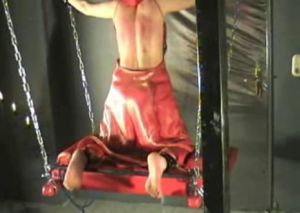Falaka
A Falaka was originally a Persian instrument of physical punishment used to immobilize offenders who would then be punished by having the soles of the feet beaten with rods.
- Bastinado and similar names, such as bastonnade in French, though not particular, have often been used to render the practice without using an authentic oriental term.
Persian original
Similar to the European concept of stocks, the barefoot subject was made to lie down on their back, their feet fastened to a two-metre pole with a loop in the middle made of either leather or rope. The loop was held in place by passing its two ends through two holes made in the pole with knots at either end to prevent the cords from slipping through. The feet were put through the loop and the pole was twisted, tightening the loop around the feet so as to prevent release during the beating on the soles of the feet.
This type of beating is excruciatingly painful - the sole of the foot is one of the most sensitive parts of the human body. It was considered humiliating as well, and generally reserved for the lower classes, though a variant was also used in schoolrooms with unruly children.
Elsewhere
- The same word has been adopted in the Turkish language; the punishment itself was adopted with vigor and renewed zest in the Ottoman Empire and several of its Arabic and other successor Arab states, sometimes with the alternative spelling falaqa. It involves beatings on the soles of the feet, secured or not, using either a stick or a whip. Upon the beating being administered, recipients were sometimes made to walk on the bruises to inflame the soles. And, in rare and extreme instances, after receiving the beating, the wounded were made to run on wet grass or take cold showers, which would cause the skin of the feet to constrict, rupture and bleed, adding additional anguish. The method was also preferred by the Turkish as the beating itself was administered in a location that was not readily noticeable by observers. So, every day following an intense beating and administration of Falaka, the beaten could be seen to be in good health, save the slight limp.
- It is still in use as a method of torture in some countries including Syria and Turkey and was brought over from the homeland to various locales inhabited by first generation Turks.
- A modern variant using steel wire was used in Afghanistan by the Taliban in 'summary justice'.
- The same practice had also been used in United States prisons until the early 20th century
(Note the difference between Bastinado (in which the person is lying on their back), and the Falaka (in which the person is kneeling.)
| List of Spanking Implements |
|---|
|
See "sting and thud" for more on this distinction. |
Chat rooms • What links here • Copyright info • Contact information • Category:Root
